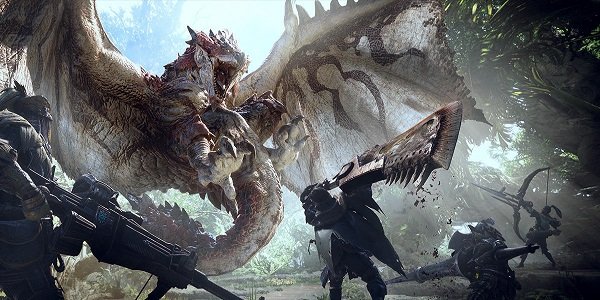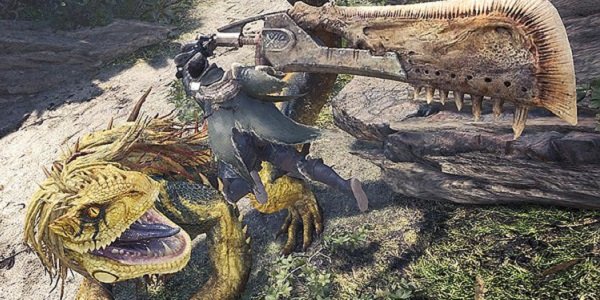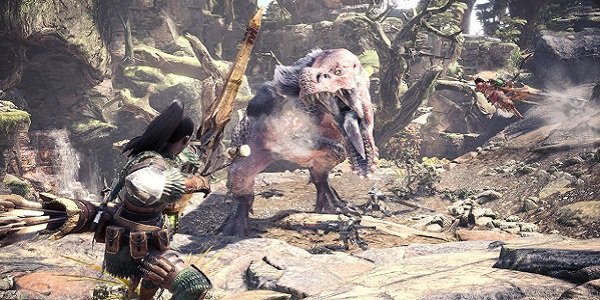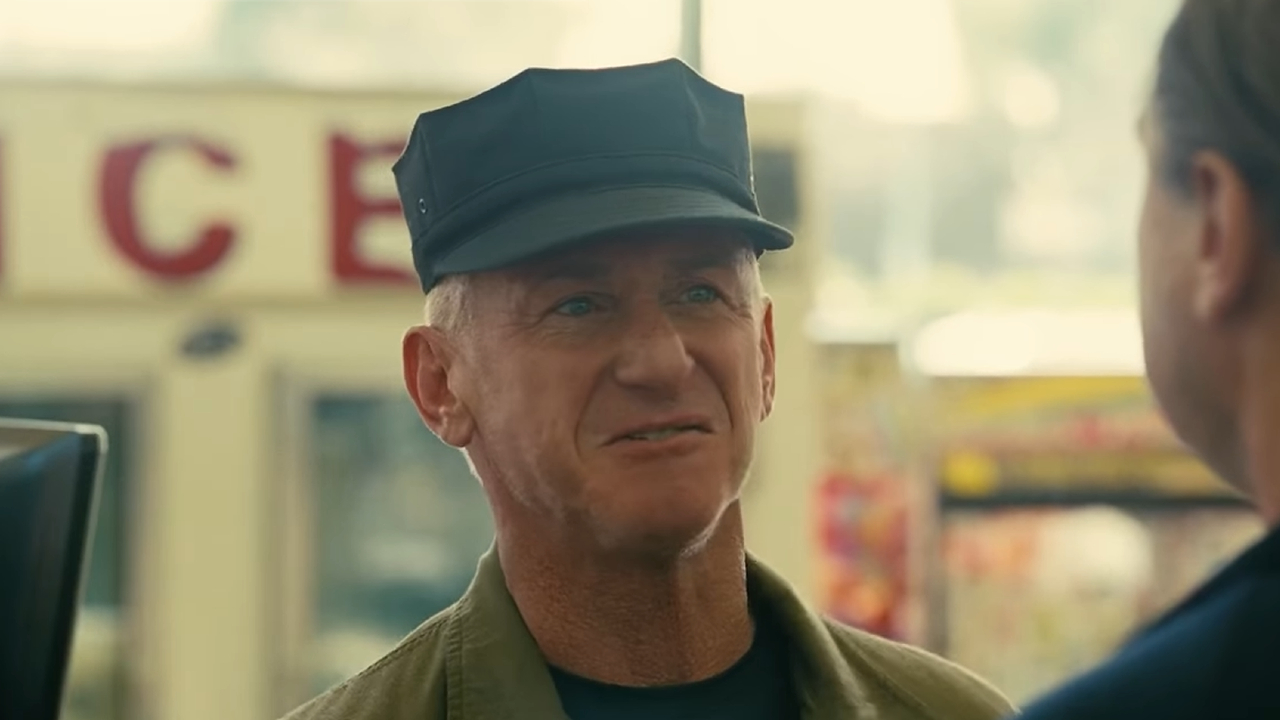Monster Hunter: World Review -- King Of The Jungle

Monster Hunter: World opens with a band of excited adventurers sailing across the ocean to reach a mysterious "New World." While this latest outing for the series still boasts the skeleton and DNA of its forbearers, I can think of no better way to illustrate the feeling I got when first settling into this sixth core Monster Hunter game that, while very familiar, still offers fresh discoveries around every corner.
As a member of the Fifth Fleet, your task is to explore the untamed wilds of the New World in order to learn about its flora and fauna and, ultimately, discover why the massive elder dragon, Zorah Magdaros, has migrated here. This premise alone demonstrates how Capcom has chosen to shake things up in Monster Hunter: World. For starters, there's an actual campaign that, while not super deep or revolutionary, offers motivation outside of the standard loop of "kill a thing, craft better gear, kill a bigger thing."
In an early conversation, it's explained that your quest in Monster Hunter: World is no longer about reclaiming land or settling a score following a village's destruction. You're on a fact-finding mission with an actual plot and (oddly unnamed) characters; the first of many ways World makes clear efforts to be more inviting to series newcomers.
I can understand that longtime fans would be wary of major changes to the popular Monster Hunter formula but, having played a couple previous entries and spending a couple dozen hours in the new game, I think it's safe to say that the alterations were all but necessary to create a title that respects the gameplay so many people already love while making itself more accessible than ever to a whole new crop of hunters.
Loading between zones on the map, for instance, has been removed, giving players a collection of massive, highly detailed maps to explore without frustrating breaks in the action. You no longer need to craft commonly used tools like the pick and gathering animations have been cut to a fraction of a second, removing some of the tedium from Monster Hunter's grind. Most importantly, though, a decent set of tutorials and introductory missions ease you into the game quickly without requiring you to tackle hours of training missions before finally going toe-to-toe with one of the series' trademark beasts.

Once you make your way to the central hub city known as Astera, you're encouraged to meet a couple of friendly faces before heading to a new training area where you can try out all 14 of the game's impressively varied weapons. You're encouraged to grab the first thing you're pretty comfortable with just to get the ball rolling and, just a couple of missions later, you'll find yourself hacking away at a Great Jagras.
From there, you'll spend your first dozen or so hours in World taking on missions and learning the ins and outs of the game's many systems; unlocking extra features along the way. Capcom wisely gives players just enough info to keep things moving, while tucking away additional tutorials for those who want to dive deeper into the details.
Your Daily Blend of Entertainment News
Don't get me wrong, figuring out Monster Hunter: World can still be a daunting task, but the campaign structure and helpful advice from NPCs go a long way to keep you moving forward rather than getting bogged down by too many details in the early goings. The idea here is that you'll get pulled along pretty quickly, learning a little bit at a time. As you start to become comfortable with the game, you'll naturally become curious about all of those finer details, layered menus, complex stat charts, etc. By that time, digging deeper will be an exciting side task rather than a long-winded, potentially interest-killing introduction.
On top of the campaign, Monster Hunter: World offers an impressive suite of activities and challenges to keep players coming back for more. You'll juggle bounties, head out on Expeditions, earn Research Points, take on a seemingly endless list of Investigations and plow through special promotional events. And while this is the easiest (relatively speaking) Monster Hunter game to play solo, Capcom has included a number of ways to encourage players to group up and tackle missions as a squad.

You can quickly join a mission with random players, respond to calls for help from your fellow hunters and, if you find yourself in a tight spot, send up an SOS to ask other players to seamlessly jump into your mission and lend a hand. The only downside to multiplayer is that it utilizes an odd code system to team up with friends you actually know, so I'm hopeful a less convoluted system will be implemented at some point.
Either way, you're free to slay monsters all by your lonesome or jump into battles with other players, all with very little muss or fuss. Losing the portability enjoyed by most recent Monster Hunter games can certainly be considered a downside, but World makes up for it by making those pulse-pounding cooperative hunts a cinch to jump into.
But whether you play by your lonesome or with friends, the actual hunting in Monster Hunter: World is better than it's ever been. Each of the game's main locations, from the Ancient Forest to the Coral Highlands, feels like its own ecosystem that's utterly crawling with creatures great and small. While the campaign weaves a yarn about studying these mysterious lands and learning about their majestic inhabitants, all of that jibba-jabba is at odds with what you are primarily here to do: Whack massive lizards with weapons twice the size of your body.
As in previous Monster Hunter games, you're going to spend a lot of your time murdering countless hordes of creatures in order to harvest their parts, build better gear, and then hunt even bigger creatures. As noted earlier, there are 14 main weapons and, while there are no fresh additions to the roster, the tools at your disposal are as varied as ever. No matter what your preferred play style is, there's something here you'll likely be comfortable with. From slow and powerful hammers to fast and agile dual blades, to firearms perfect for people who like to run and gun, there's a weapon for every type of hunter. If you just want to hack away at the beasts without learning anything too fancy, a sword and shield might be your best option. If you like combat to be a bit more methodical, you could lean toward a charge blade or insect glaive.

Once you've found your weapon of choice, there's plenty to take into account outside of slaying beasts. For starters, you actually have to hunt them this time around. This process starts with you finding things like footprints or rubbings out in the world. Once these are investigated, your helpful soutflies will latch onto the scent and start leading you to the next track. Once they've got a full handle on the scent, they'll take you directly to the brute.
After a while, you'll start to learn the traditional habitats for the game's various creatures, as well as the areas they're typically willing to venture into. And leading up to big battles, you'll have plenty of ways to keep yourself occupied such as fishing, catching insects or gathering an insane number of resources that you can then mix together to create helpful items or better gear.
I feel like I'm only scraping the surface here, which is why Monster Hunter: World is so exciting. At a glance, it really does boast a simple loop of hunt, kill, harvest, craft, repeat. But there are so many ways to go about those activities, and so many wonderful distractions nestled into its nooks and crannies, that's it's easy to lose yourself in the adventure. It's the type of game that frequently had me saying, "just one more hunt." Considering those hunts can last a solid hour, I consider it a pretty impressive feat that Monster Hunter: World managed to sink its hooks in so deep.
This latest outing into the world of Monster Hunter is exactly the evolution the series needed. It's got all of the trapping experienced players have grown to expect while amputating a lot of tedium and offering a means of entry for newcomers that makes an intimidating Anjanath feel more like a manageable Kelbi. Okay, that's a bit of a stretch for comparison, but the point is that Capcom went the extra mile to make a very complex game as welcoming as possible to novices.
From the mechanics to the environments, the monsters and everything in between, it's hard not to see this as a top to bottom improvement. There's plenty of meat on these bones; and pretty much every scrap of it is worth harvesting.
This review based on a PlayStation 4 download copy provided by the publisher.
Staff Writer for CinemaBlend.

